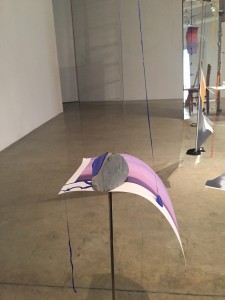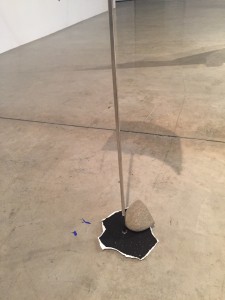
While Sarah Sze’s last show at Tanya Bonakdar consisted of several dazzling, sensorial and thought-provoking installations, one modest, barely there assemblage lingers in my mind’s eye. Entitled Lavender Landscape Standing (2015), it consisted of a small (perhaps 3 x 2 inch) rock that had been split down the middle, two torn sheets of paper, one all black, the other in shades of lavender, apparently fragments of images printed out from the Internet, and tiny blobs and thread-like strings of blue paint supported by (or otherwise set in relation to) a tall, thin stainless steel armature.
This was just one of a myriad of freestanding pieces that made up the environmental installation occupying the main downstairs space in Sze’s exhibition, which extended from September 10 to October 17, 2015. (Sze, for those unfamiliar with the artist, is pronounced “Zee.”) Sze intended this gallery space to simulate her studio and provide a feeling of work in progress. To that end, it incorporated wooden planks and pieces of cardboard on the floor and wooden beams, lighting fixtures and wires hanging from the ceiling, as well as lengths of draped plastic, two ladders and a worktable. As can be seen in the white “curtain” and blue hanging fragment (at the extreme right) in the installation photograph included here, a notable feature in this exhibition was her use of hardened swaths of paint–dried paint, independent of any support–also found in the “threads” and tiny morsels in Lavender Landscape Standing.

There are a number of things that captivate me about this work. One is that while being practically immaterial, it conveys a sense of monumentality, by virtue, perhaps, of its verticality and the presence of the rocks, which connote permanence. Its perfect balance and seeming openness to air currents recalls the “engineered” work of Alexander Calder. At the same time, however, the work appears utterly fragile–one would think that just to touch or move it, much less attempt to live with it in an actual home (kids, dogs, yikes!), would mean its immediate demise. Further, it appears to have been a spontaneous improvisation on the part of the artist, a record of a fleeting moment of inspiration, incapable of sustained existence.

Yet, when I spoke with the artist about this in the space of the exhibition, she picked up the piece in one hand and walked around the room. She also lifted the tiny blue dried “paint chips” up off the floor and placed them in my hand, explaining that a few extra paint fragments accompany the sale of the work. So too does a digital file for the reprinting of the scraps of paper, should they become damaged, although she has no expectation that this will occur. This piece then, which literally appears to be hanging by a thread, is not as momentary as it appears. It nevertheless rouses in me a feeling of wanting to protect and preserve.

The strength of the assemblage resides too in its balance of mental forces and poetic evocations. As the title suggests, the work appears to be Sze’s version of a (and perhaps “the”) contemporary landscape. Acrylic paint in a pure and physical form is brought together with computer-generated images in a meeting of past and present art media. Whether the lavender digital print-out was derived from an online landscape photograph is uncertain, but the idea of landscape is reinforced by the rock pieces, which in their divided state, speak of nature altered. Nature meets culture, a dreamy lavender and vivid blue meet gray rock and steel and fragility meets sustainability in a work whose fragments left lasting imprints on both my palm and mind.